Experimental Research on the Effect of Sugarcane Stalk Lifting Height on the Cutting Breakage Mechanism Based on the Sugarcane Lifting–Cutting System (SLS)
Abstract
:1. Introduction
2. Analysis of the Working Principle and Parameters of the SLS
2.1. Working Principle of the SLS
2.2. Analysis of Operational Parameters of SLS
3. Simulation Analysis of SLS
4. Materials and Methods
4.1. Test Platform
4.2. Test Factors and Levels
4.3. Evaluation Indicators
5. Results and Discussion
5.1. Test Results
5.2. Significance Analysis of CBG
5.3. Response Surface Analysis
5.4. Experimental Results and Discussion
6. Conclusions
Author Contributions
Funding
Institutional Review Board Statement
Informed Consent Statement
Data Availability Statement
Conflicts of Interest
References
- Salassi, M.E.; Breaux, J.B.; Naquin, C.J. Modeling within-season sugarcane growth for optimal harvest system selection. Agric. Syst. 2002, 73, 261–278. [Google Scholar] [CrossRef]
- Enrique, A.; Graciela, B.; Luis, S. An activity simulation model for the analysis of the harvesting and transportation systems of a sugarcane plantation. Comput. Electron. Agric. 2001, 32, 247–264. [Google Scholar]
- Driemeier, C.; Ling, L.; Sanches, G.M. A computational environment to support research in sugarcane agriculture. Comput. Electron. Agric. 2016, 130, 13–19. [Google Scholar] [CrossRef]
- Xie, D.; Chen, L.; Liu, L.; Chen, L.; Wang, H. Actuators and Sensors for Application in Agricultural Robots: A Review. Machines 2022, 10, 913. [Google Scholar] [CrossRef]
- Xie, L.; Wang, J.; Cheng, S.; Zeng, B.; Yang, Z. Optimisation and finite element simulation of the chopping process for chopper sugarcane harvesting. Biosyst. Eng. 2018, 175, 19–26. [Google Scholar] [CrossRef]
- Ma, S.; Karkee, M.; Scharf, P.A.; Zhang, Q. Sugarcane Harvester Technology: A Critical Overview. Appl. Eng. Agric. 2014, 30, 727–739. [Google Scholar]
- Xing, H.; Ma, S.; Wang, F. Aerodynamic Performance Evaluation of Sugarcane Harvester Extractor Based on CFD. Sugar Tech 2021, 23, 627–633. [Google Scholar] [CrossRef]
- Wang, Y.; Cai, J.; Zhang, D.; Chen, X.; Wang, Y. Nonlinear Correction for Fringe Projection Profilometry with Shifted-Phase Histogram Equalization. Trans. Instrum. Meas. 2022, 71, 5005509. [Google Scholar] [CrossRef]
- Ou, Y.; Malcolm, W.; Yang, D.; Liu, Q.; Zheng, D.; Wang, M.; Liu, H. Mechanization technology: The key to sugarcane production in China. Int. J. Agric. Biol. Eng. 2013, 6, 1–27. [Google Scholar]
- Balakrishnan, P.M. Labour Scarcity and Selective Mechanisation of Sugarcane Agriculture in Tamil Nadu, India. Sugar Tech 2012, 14, 223–228. [Google Scholar]
- Hu, J.; Ma, S.; Wang, F.; Xing, H.; Ma, J.; Hu, J. Design and Development of Sugarcane Top Chopper and its Field Performance. Sugar Tech 2021, 23, 1192–1198. [Google Scholar] [CrossRef]
- Wu, T.; Liang, X.; Liu, Q. Chopper Sugarcane Combine Harvester with Middle-Mounted Primary Extractor. Sugar Tech 2020, 22, 589–595. [Google Scholar] [CrossRef]
- Wang, F.; Ma, S.; Xing, H.; Bai, J.; Ma, J.; Wang, M. Effect of Contra-Rotating Basecutter Parameters on Basecutting Losses. Sugar Tech 2020, 23, 278–285. [Google Scholar] [CrossRef]
- Edemilson, J.M.; Marcos, M.; Leandro, M.G.; Thiago, L.R. Embodied energy of sugarcane harvesters. Biosyst. Eng. 2014, 118, 156–166. [Google Scholar]
- Wang, M.; Liu, Q.; Ou, Y.; Zou, X. Experimental Study of the Planting Uniformity of Sugarcane Single-Bud Billet Planters. Agriculture 2022, 12, 983. [Google Scholar] [CrossRef]
- Wang, M.; Liu, Q.; Ou, Y.; Zou, X. Numerical Simulation and Verification of Seed-Filling Performance of Single-Bud Billet Sugarcane Seed-Metering Device Based on EDEM. Agriculture 2022, 12, 908. [Google Scholar] [CrossRef]
- Bai, J.; Ma, S.; Wang, F.; Xing, H.; Ma, J.; Hu, J. Field test and evaluation on crop dividers of sugarcane chopper harvester. Int. J. Agric. Biol. Eng. 2021, 14, 118–122. [Google Scholar] [CrossRef]
- Song, C.; Qu, Y.; Liu, Q.; Wang, M. Experimental study on influencing factors of lifting quality for push-over-type sugarcane harvester. Trans. CSAE 2012, 28, 35–40. [Google Scholar]
- Silva, J.; Ralisch, R.; Saab, O. Identification and Quantification of Factors Affecting the Operational Capacity of Sugar Cane Harvesters. Eng. Agrícola 2018, 38, 563–567. [Google Scholar] [CrossRef]
- Kroes, S.; Harris, H.D. Effect of basecutter and crop parameters on permissible cane harvester speeds. Agric. Eng. Aust. 1994, 24, 43–48. [Google Scholar]
- Kroes, S.; Harris, H.D. Effect of cane harvester basecutter parameters on the quality of cut. Proc. Aust. Soc. Sugar Cane Technol. 1994, 16, 169–177. [Google Scholar]
- Liu, Q.; Ou, Y.; Qin, S.; Wang, W. Stubble damage of sugarcane stalks in cutting test by smooth-edge blade. Trans. CSAE 2007, 23, 103–107. [Google Scholar]
- Qin, S.; Qu, Y.; Liu, Q. Kinematics of Single Disc Basecutter of Sugarcane Harvester. Trans. CSAM 2006, 37, 51–54. [Google Scholar]
- Xiang, J.; Yang, L.; Li, S. Experimental investigation of the basecutter for minitype sugarcane harvester. Trans. CSAE 2007, 23, 158–163. [Google Scholar]
- Yang, J.; Liang, Z.; Mo, W.; Gu, Y. Experimental research on factors affecting the cutting quality of sugarcane cutter. Trans. CSAE 2005, 21, 60–64. [Google Scholar]
- Qiu, M.; Meng, Y.; Li, Y. Sugarcane stem cut quality investigated by finite element simulation and experiment. Biosyst. Eng. 2021, 206, 135–149. [Google Scholar] [CrossRef]
- Yang, W.; Zhao, W.; Liu, Y. Simulation of forces acting on the cutter blade surfaces and root system of sugarcane using FEM and SPH coupled method. Comput. Electron. Agric. 2021, 180, 105893. [Google Scholar] [CrossRef]
- Chen, X.; Tang, L.; Liu, B.; Lv, L.; Yang, M.; Yang, J. Dynamic analysis and simulation of the cutting system of sugarcane harvester. J. Chin. Agric. Mech. 2018, 39, 27–30. [Google Scholar]
- Lucas, A.S.G.; Rouverson, P.S.; Patricia, C.M.; Fanciele, M.C.; Cristiano, Z.; Antonio, T.S.O. Quality of multi-row harvesting in sugarcane plantations established from pre-sprouted seedlings and billets. Ind. Crops Prod. 2019, 142, 111831. [Google Scholar]
- Wang, Q.; Zhang, Q.; Zhang, Y.; Zhou, G.; Li, Z. Lodged Sugarcane/Crop Dividers Interaction: Analysis of Robotic Sugarcane Harvester in Agriculture via a Rigid-Flexible Coupled Simulation Method. Actuators 2022, 11, 23. [Google Scholar] [CrossRef]
- Liang, X.; Chen, L.; Wang, Y.; Wan, L. A proposed torque calculation model for multi-plate clutch considering boundary lubrication conditions and heat transfer. Int. J. Heat Mass Transf. 2020, 157, 119732. [Google Scholar] [CrossRef]
- Chen, L.; Ma, P.; Tian, J.; Liang, X. Prediction and optimization of lubrication performance for a transfer case based on computational fluid dynamics. Eng. Appl. Comput. Fluid Mech. 2019, 13, 1013–1023. [Google Scholar] [CrossRef] [Green Version]
- Zhang, Z.; Jia, X.H.; Yang, T.; Gu, Y.L.; Wang, W.; Chen, L.Q. Multi-objective optimization of lubricant volume in an ELSD considering thermal effects. Int. J. Therm. Sci. 2021, 164, 106884. [Google Scholar] [CrossRef]
- Chen, Y. Study on the Simulation Model of Sugarcane—Soil System; Guangxi University: Nanning, China, 2008. [Google Scholar]
- Kroes, S. The cutting of sugarcane. Ph.D. Thesis, University of Southern Queens, Toowoomba, Australia, 1997. [Google Scholar]
- Zhou, J. Small Sugar Cane Harvester Cutting System Optimized Design and Test Research; Guangxi University: Nanning, China, 2013. [Google Scholar]
- GB/T 6275-2007. Sugarcane Harvesting Machinery Test Methods. Machinery industry standards of the People’s Republic of China. National Development and Reform Commission: Beijing, China.
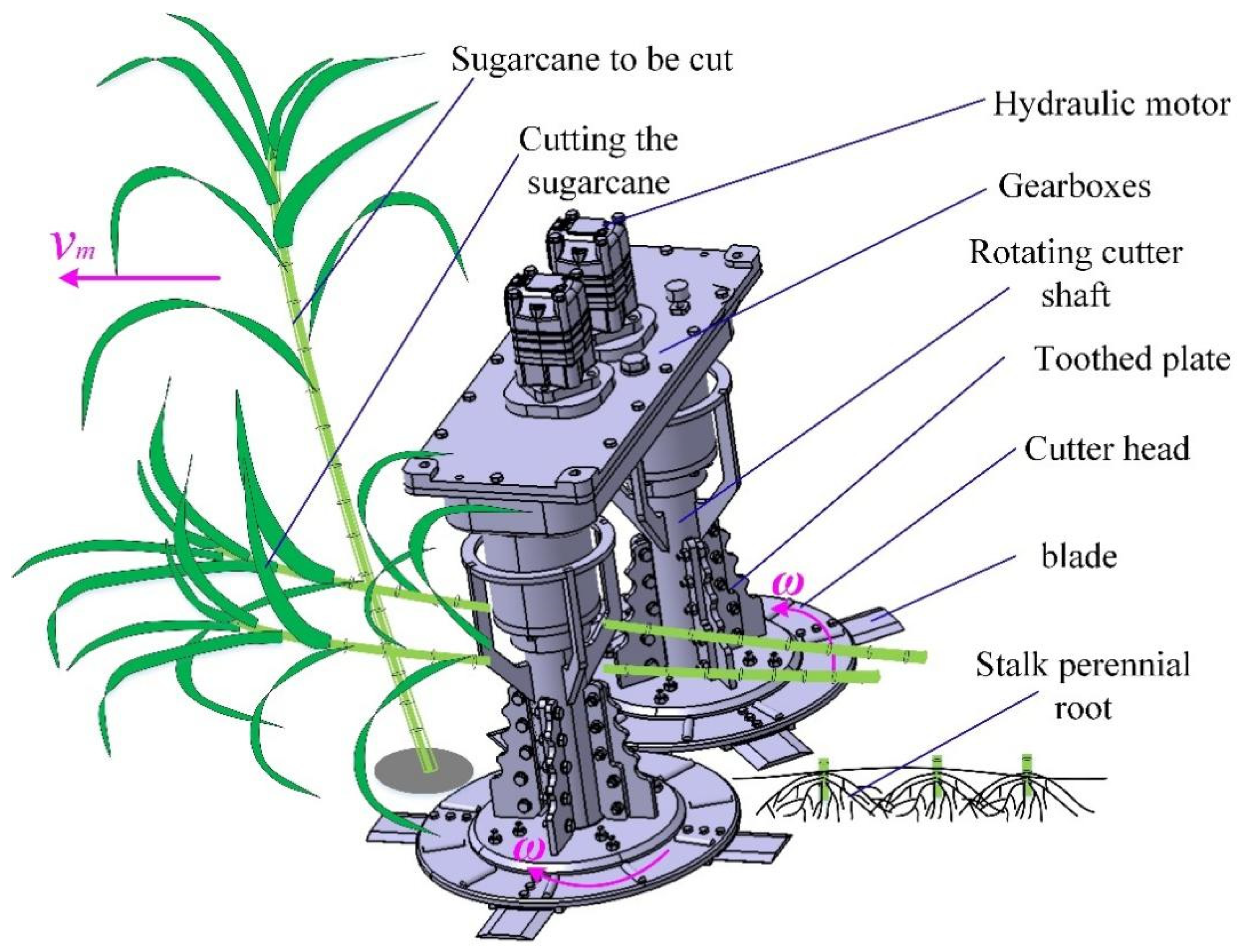
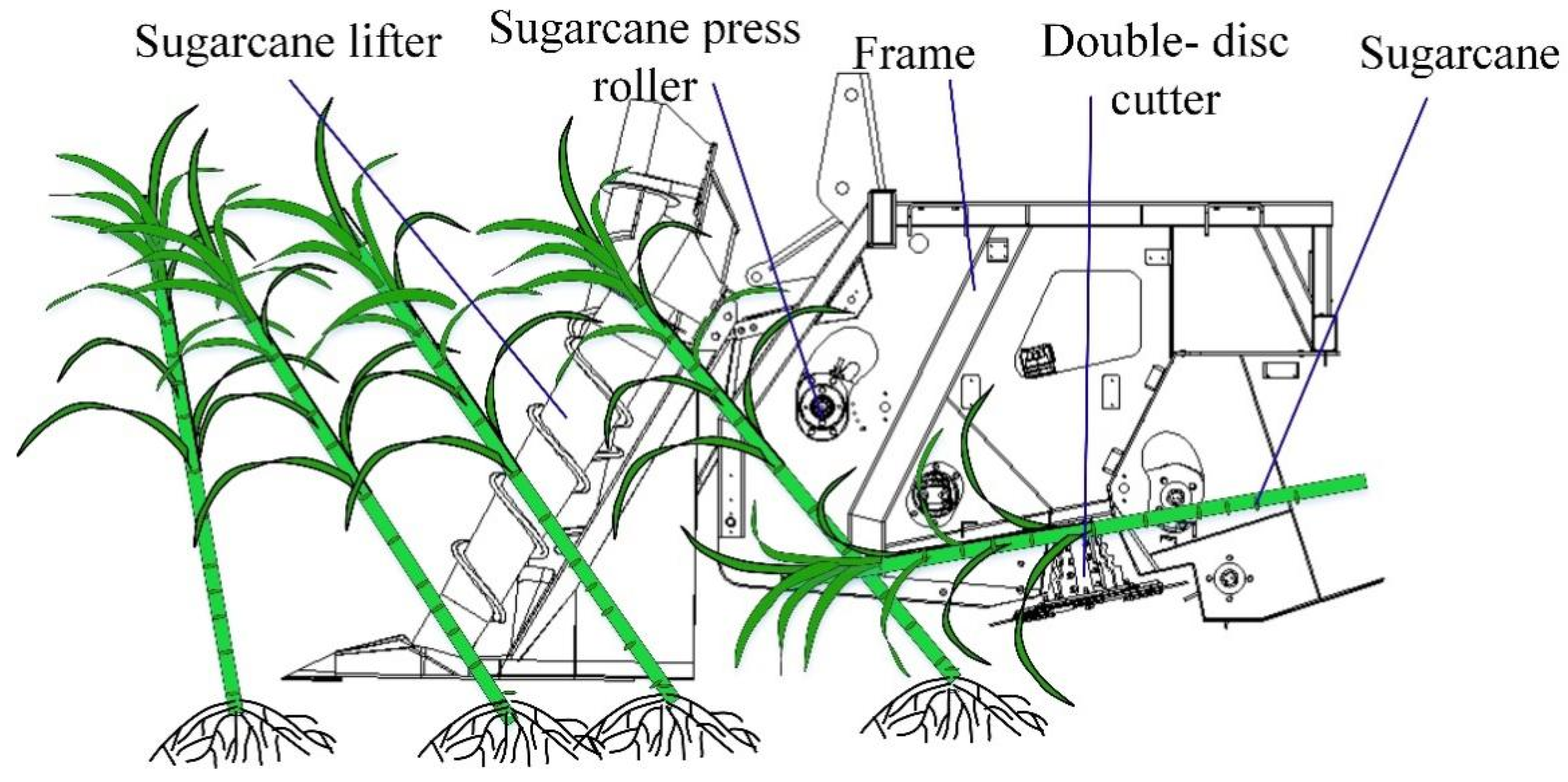
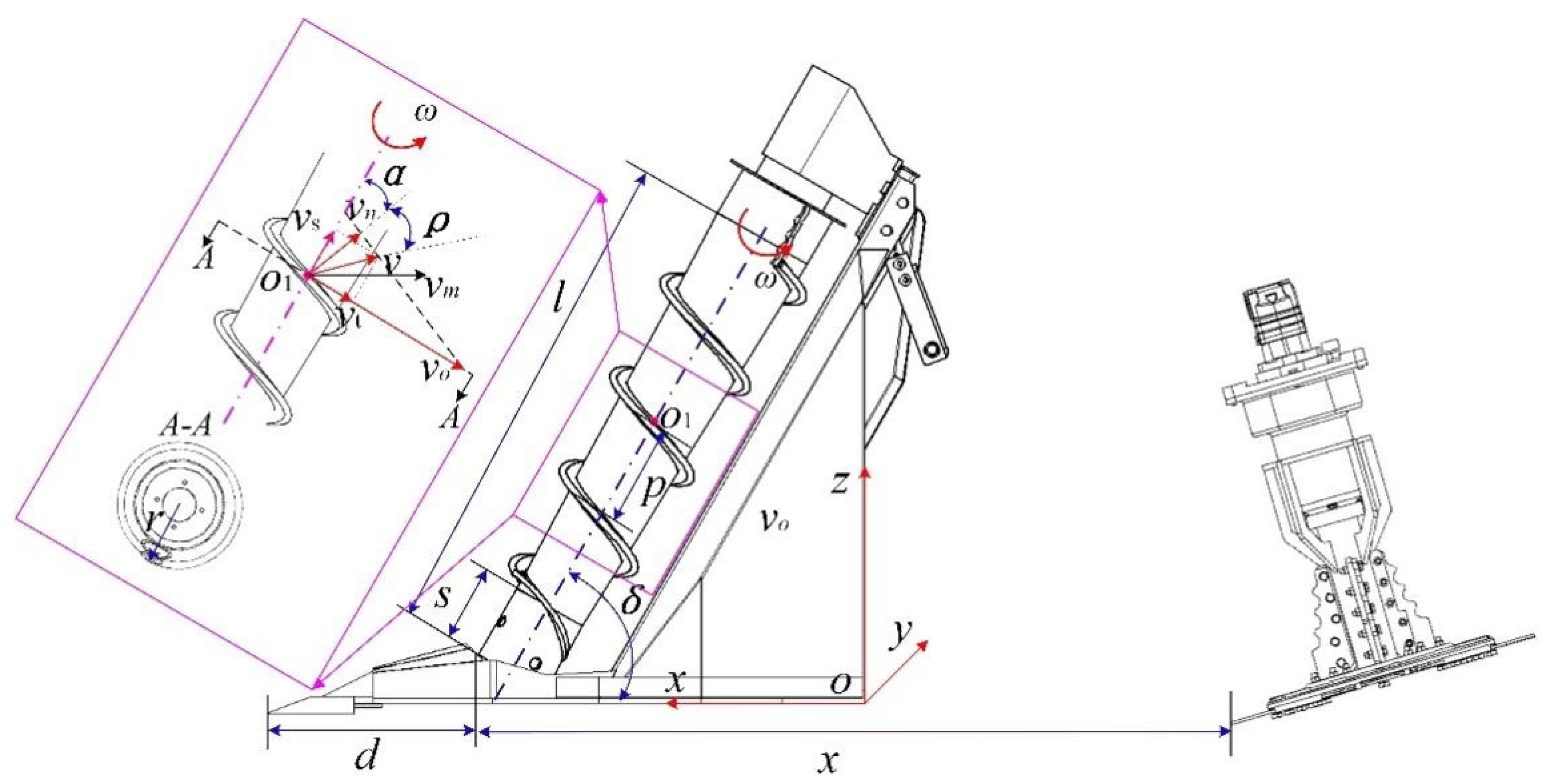
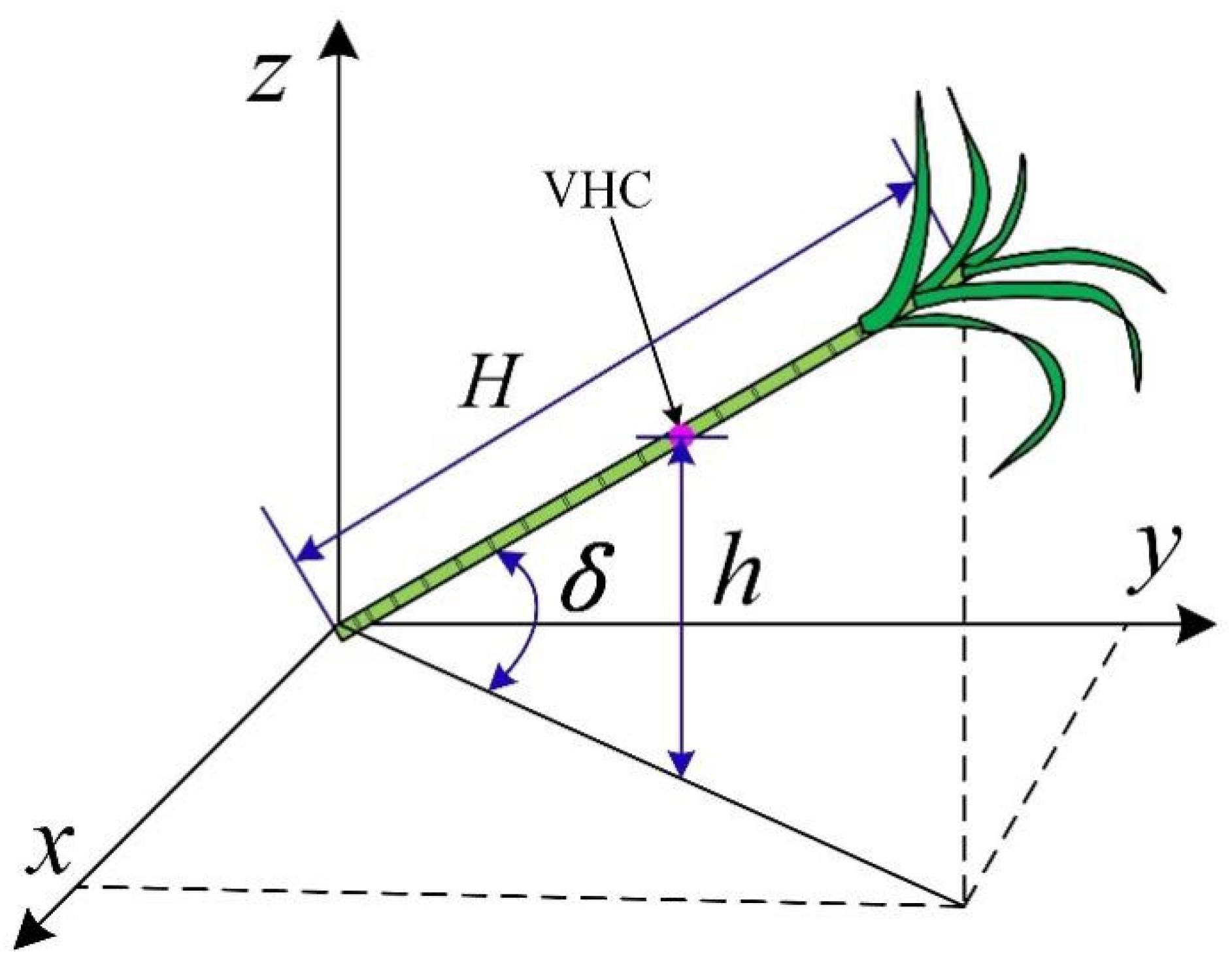

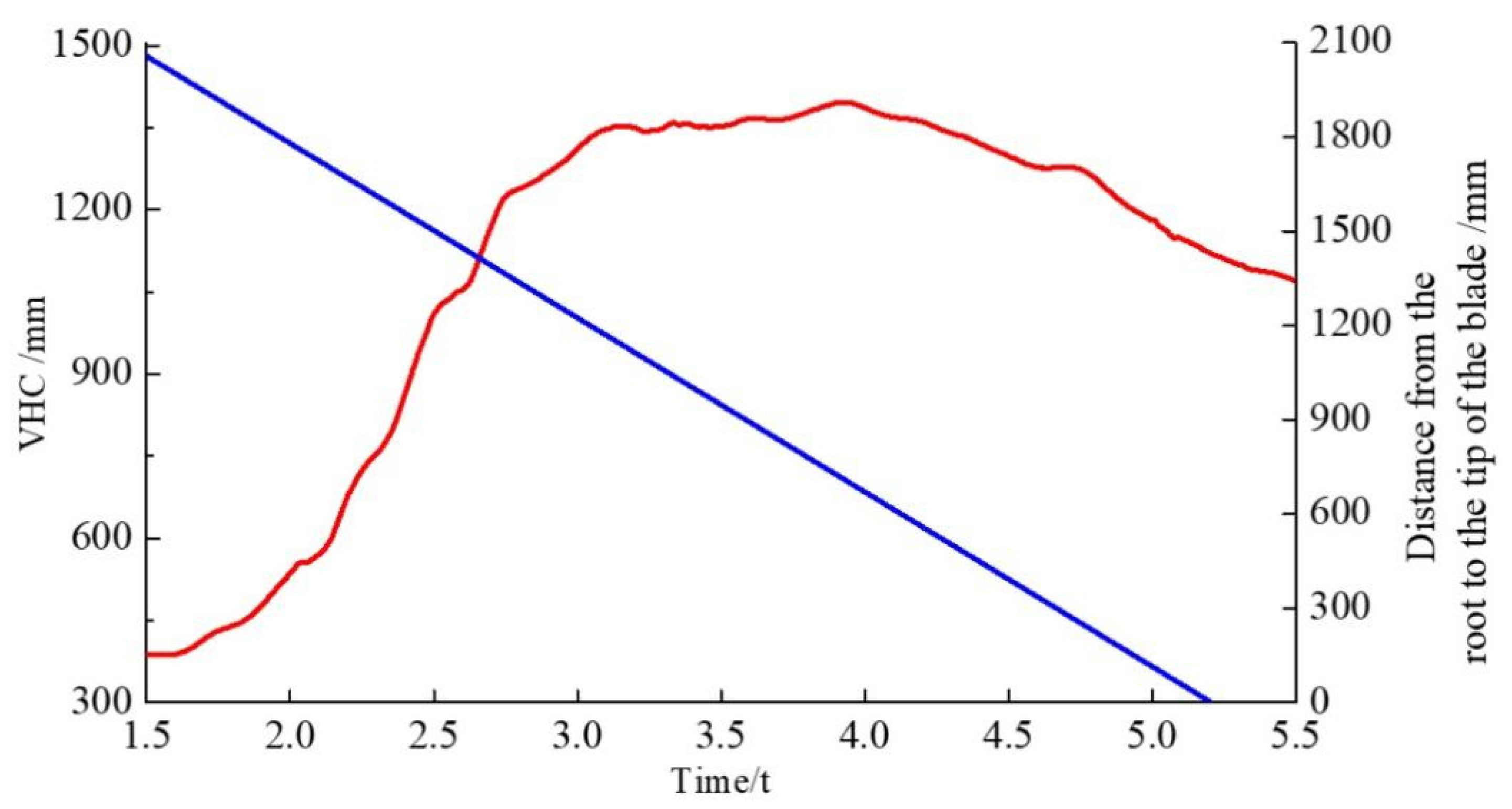
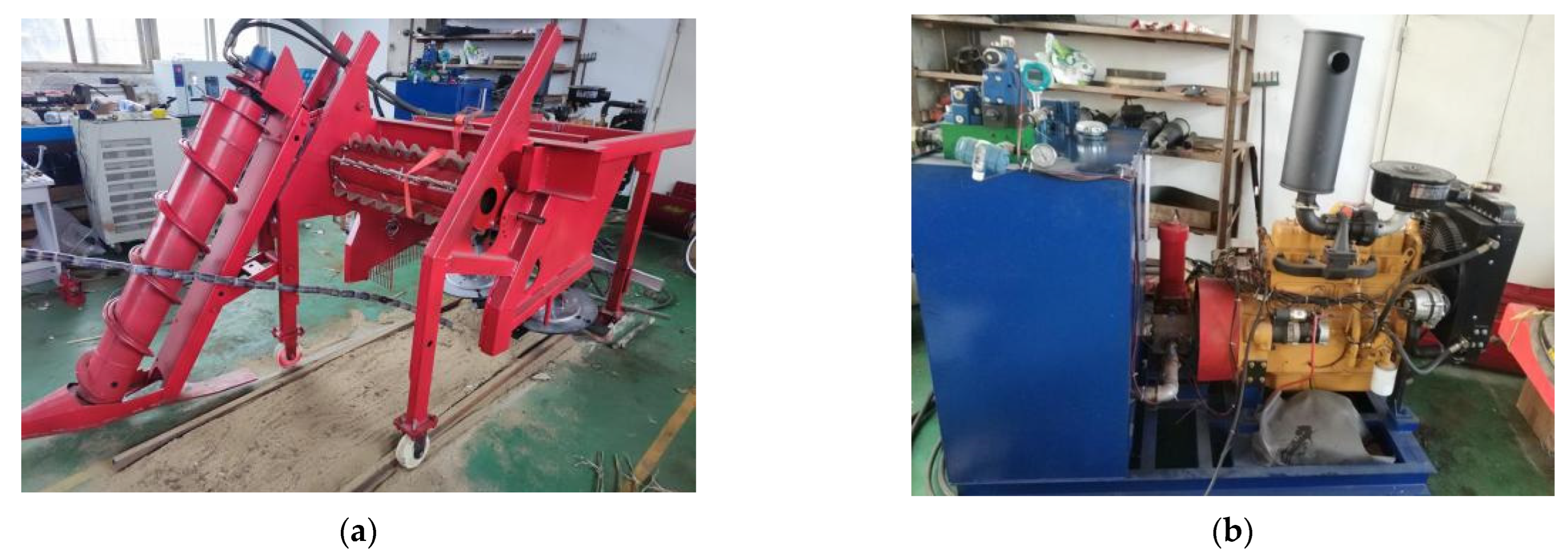

| Code Value | Test Factors | ||
|---|---|---|---|
| VHC m (X1) | Forward Velocity km/h (X2) | Cutter Rotational Speed rpm (X3) | |
| 1.681 | 1.3 | 3.0 | 650 |
| 1 | 1.1 | 2.6 | 630 |
| 0 | 0.8 | 2.0 | 600 |
| −1 | 0.5 | 1.4 | 570 |
| −1.681 | 0.3 | 1.0 | 550 |
| Broken Forms | Damage Effect Drawing | CBG | ||
|---|---|---|---|---|
| No damage | 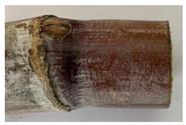 | 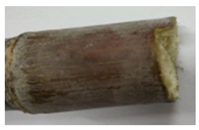 |  | 0 |
| Slight sugarcane skin damage |  | 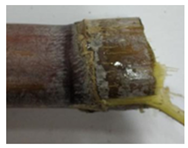 |  | 1 |
| Severesugarcane skin damage or slight sugarcane splitting |  |  | 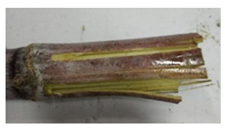 | 2 |
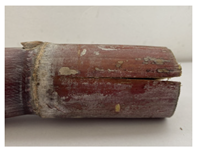 |  |  | ||
| Splitting damage | 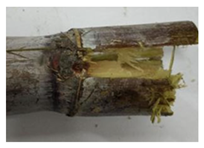 | 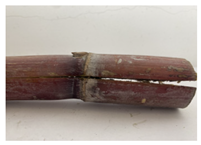 |  | 3 |
| Severe splitting and bursting | 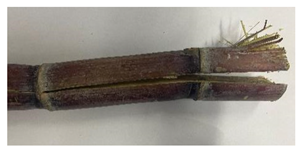 | 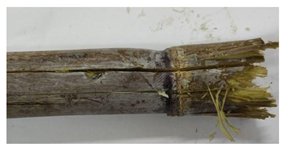 | 4 | |
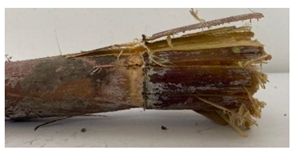 |  | |||
| Test Serial Number | Test Factors | Evaluation Indicators | ||
|---|---|---|---|---|
| X1 | X2 | X3 | Y | |
| 1 | 0 | 0 | 0 | 1.2 |
| 2 | −1.681 | 0 | 0 | 3.2 |
| 3 | 1 | −1 | −1 | 0.8 |
| 4 | 0 | 0 | 1.681 | 2 |
| 5 | 0 | 0 | −1.681 | 1.8 |
| 6 | −1 | −1 | −1 | 2 |
| 7 | 1 | 1 | 1 | 1.2 |
| 8 | 0 | −1.681 | 0 | 0.8 |
| 9 | 0 | 1.681 | 0 | 2.6 |
| 10 | 1.681 | 0 | 0 | 1.4 |
| 11 | 1 | 1 | −1 | 1.2 |
| 12 | 0 | 0 | 0 | 1.8 |
| 13 | 0 | 0 | 0 | 1.2 |
| 14 | 0 | 0 | 0 | 0.8 |
| 15 | 0 | 0 | 0 | 1.6 |
| 16 | −1 | −1 | 1 | 1.6 |
| 17 | −1 | 1 | −1 | 2.4 |
| 18 | −1 | 1 | 1 | 2.2 |
| 19 | 0 | 0 | 0 | 1 |
| 20 | 1 | −1 | 1 | 0.8 |
| Source of Variance | SS | df | MS | F | p |
|---|---|---|---|---|---|
| Model | 6.73 | 9 | 0.7473 | 4.09 | 0.0192 * |
| X1 | 3.82 | 1 | 3.82 | 20.95 | 0.0010 ** |
| X2 | 1.71 | 1 | 1.71 | 9.34 | 0.0121 * |
| X3 | 0.0051 | 1 | 0.0051 | 0.0279 | 0.8707 |
| X1X2 | 0.0050 | 1 | 0.0050 | 0.0274 | 0.8719 |
| X1X3 | 0.0450 | 1 | 0.0450 | 0.2465 | 0.6303 |
| X2X3 | 0.0050 | 1 | 0.0050 | 0.0274 | 0.8719 |
| X12 | 0.9981 | 1 | 0.9981 | 5.47 | 0.0415 * |
| X22 | 0.0375 | 1 | 0.0375 | 0.2056 | 0.6599 |
| X32 | 0.2136 | 1 | 0.2136 | 1.17 | 0.3048 |
| Residual | 1.83 | 10 | 0.1826 | – | – |
| Loss of proposed items | 1.13 | 5 | 0.2265 | 1.63 | 0.3017 |
| Pure error | 0.6933 | 5 | 0.1387 | – | – |
| Total value | 8.55 | 19 | – | – | – |
Publisher’s Note: MDPI stays neutral with regard to jurisdictional claims in published maps and institutional affiliations. |
© 2022 by the authors. Licensee MDPI, Basel, Switzerland. This article is an open access article distributed under the terms and conditions of the Creative Commons Attribution (CC BY) license (https://creativecommons.org/licenses/by/4.0/).
Share and Cite
Wang, Q.; Zhou, G.; Huang, X.; Song, J.; Xie, D.; Chen, L. Experimental Research on the Effect of Sugarcane Stalk Lifting Height on the Cutting Breakage Mechanism Based on the Sugarcane Lifting–Cutting System (SLS). Agriculture 2022, 12, 2078. https://doi.org/10.3390/agriculture12122078
Wang Q, Zhou G, Huang X, Song J, Xie D, Chen L. Experimental Research on the Effect of Sugarcane Stalk Lifting Height on the Cutting Breakage Mechanism Based on the Sugarcane Lifting–Cutting System (SLS). Agriculture. 2022; 12(12):2078. https://doi.org/10.3390/agriculture12122078
Chicago/Turabian StyleWang, Qingqing, Guoan Zhou, Xin Huang, Jiale Song, Dongbo Xie, and Liqing Chen. 2022. "Experimental Research on the Effect of Sugarcane Stalk Lifting Height on the Cutting Breakage Mechanism Based on the Sugarcane Lifting–Cutting System (SLS)" Agriculture 12, no. 12: 2078. https://doi.org/10.3390/agriculture12122078
APA StyleWang, Q., Zhou, G., Huang, X., Song, J., Xie, D., & Chen, L. (2022). Experimental Research on the Effect of Sugarcane Stalk Lifting Height on the Cutting Breakage Mechanism Based on the Sugarcane Lifting–Cutting System (SLS). Agriculture, 12(12), 2078. https://doi.org/10.3390/agriculture12122078







